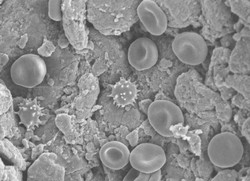Novel adsorbents for life-threatening conditions
Haemoadsorption is a way of removing toxic molecules from patient blood by passing in direct contact with an adsorbent material contained in an extracorporeal medical device. Poor biocompatibility of uncoated adsorbents is currently resolved by coating adsorbent granules with haemocompatible coatings, but this can reduce efficiency of toxin removal. The MEAD-ET (Novel medical adsorbents for extracorporeal treatment of life threatening conditions) project developed novel adsorbents and then tested them for blood compatibility and their adsorption efficiency in medical applications. During the first 24 months of the project, MEAD-ET developed, optimised and characterised activated carbon materials (ACMs), which were then further activated using a super-heated steam activation process. Characterisation of these ACMs using electron microscopy analysis and porosimetry established the effect of activation on the carbon material resulting in a further developed nanopore structure and increased surface area. The scientists coated the carbon beads with biocompatible molecules such as dextran and tested coated and uncoated ACM for adsorptive capacity for a range of marker toxins such as; bilirubin, albumin, creatinine, cytokines, vitamin B12 and methylene blue. Results indicated that further activation of ACM increased surface area, nanopore volume and improved adsorption capacity for marker molecules. Whereas, a dextran coating (5-30 % weight of ACM) did reduce uptake of these molecules, a partial 5 % coating maintained adsorption capacity, with the advantage of minimizing fines (small particulates) production and albumin adsorption. The haemocompatibility and cytotoxicity of the dextran-coated beads was investigated according to the ISO guidelines. Cytotoxicity tests suggested that materials with varying porosity or surface coating did not have any significant effect on the results obtained, with ACM considered non-cytotoxic to cells. Even the partially coated materials did not activate the inflammatory response and thus could be considered haemocompatible, with the dextran coating reducing fibrinogen adsorption and complement generation, suggesting the ACM warrants continued development for haemoadsorption applications. The project concluded that choosing the optimal material for a blood purification application is a balance between quantity of coating to ensure good haemocompatibility and low fine production without hindering adsorption properties. Results of the project were presented in several publications, a joint project international conference at the University of Brighton and a project workshop at the National Academy of Sciences of Ukraine. The efforts of this ongoing project are tackling serious health conditions and improving patients' quality of life, as well as reducing the cost burden to the health service. Potential applications include kidney and liver failure, sepsis, systemic inflammation and immune-dependent diseases.







